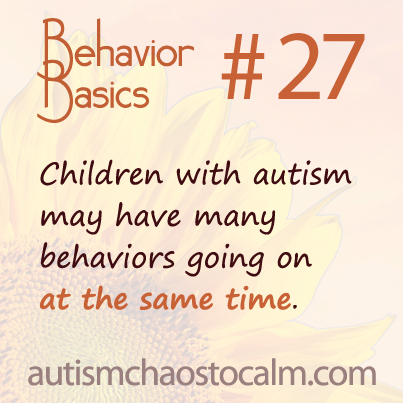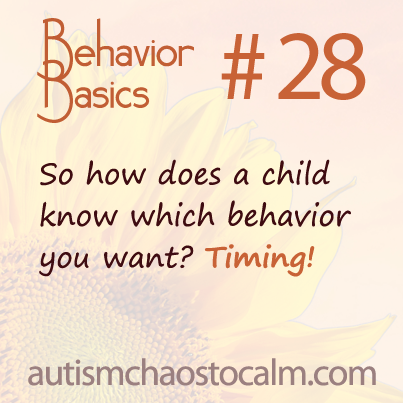 27. Children with autism have many behaviors going on at the same time.
27. Children with autism have many behaviors going on at the same time.
Another way of saying this is that children with autism may have many physical movements going on at the same time. Children with autism can be extremely physically active. If you observe them, you may see that the hands, arms, legs, torso, neck, head, facial and vocal muscles are all active at once. Take the time to observe your child. Download the free “Child Observation Chart” from the website below and make a note of the specific types of physical movements your child is making. When you see how many movements your child is displaying, you realize how careful you have to be when reinforcing behavior. With so much going on it is easy for the instructor to reinforce something too early or too late, and for the child to be confused about what is being reinforced.
 28. So how does a child know which behavior you want? Timing!
28. So how does a child know which behavior you want? Timing!
When a child is making multiple movements with her body, the question comes up, how does she know what you are reinforcing? She may be running, swinging her arms, swiveling her head and shouting. She may be performing a desired behavior, but that behavior appears for only a split second and is buried in an avalanche of dizzying movements. How do you pick out that micro-second of desired physical movement? The answer is: Timing. You reinforce her precisely during the split second she is performing the behavior you want. With the quick click of a tagger, TAGteach (Teaching with Acoustical Guidance) allows you to reinforce a child for a micro-second of behavior at the exact moment she is performing that behavior. Even though she is performing many movements, the child will realize that something caused a positive consequence in her world. She will quickly figure out which movement resulted in that positive outcome (kids with autism are brilliant at this), and she will repeat the movement. TAGteach is extraordinarily effective for precise timing of reinforcement. There is nothing else like it. The human voice is much too slow and too late for this type of precision reinforcement. By the time you say, “Good job,” or “That’s it,” the child will have performed many more physical movements. She won’t know which movement you are talking about, and your efforts will be wasted. Timing is critical. Timing is all important. Time–for our kids with autism–is too valuable to waste.
REMINDER: This concludes the wrap-up of Behavior Basics for the week. Please remember the schedule: On the release date of each module, the Behavior Basics for that module will be compiled into a PDF ebook available from our blog and Facebook page. Click on this link to download the entire series of 42 Behavior Basics for free: http://statictab.com/m7bizwt.